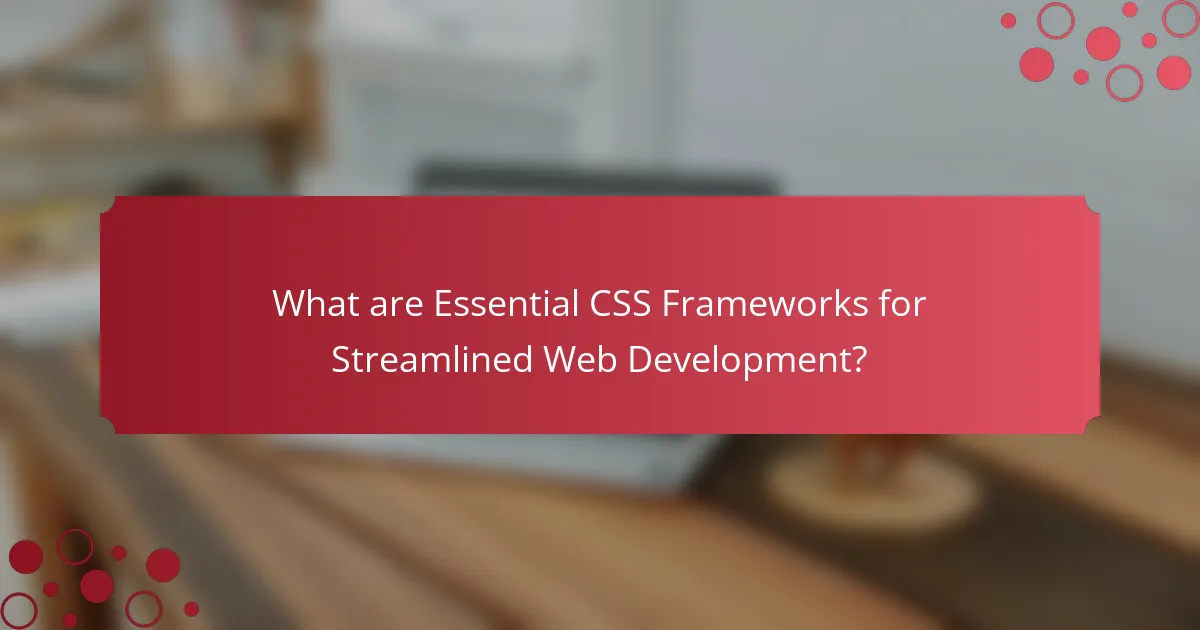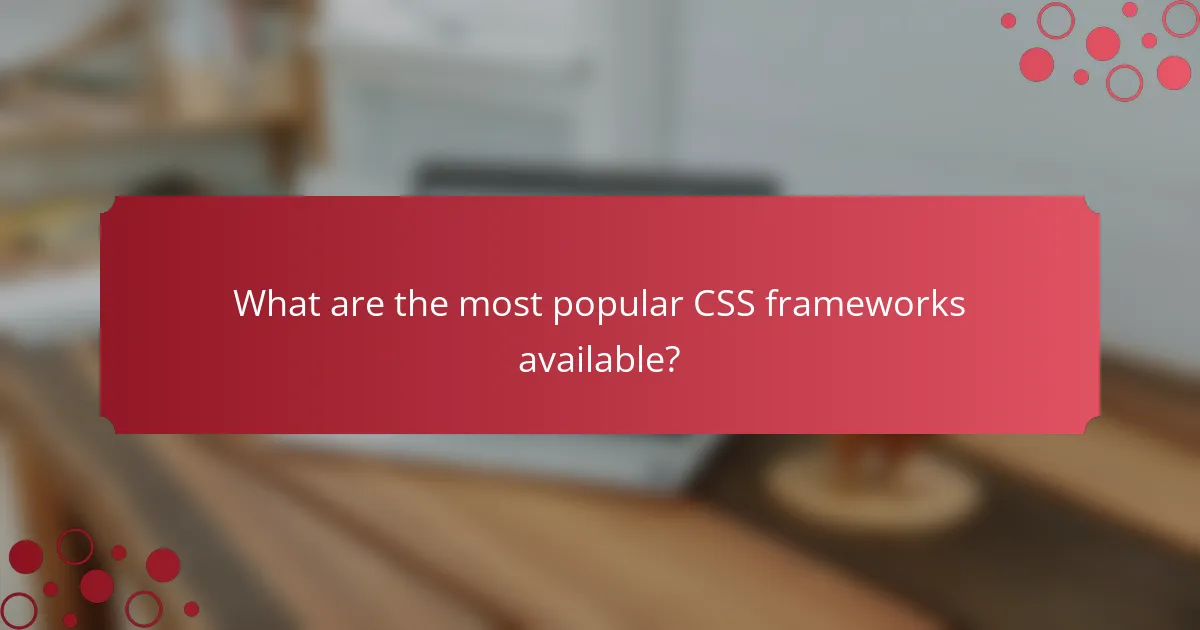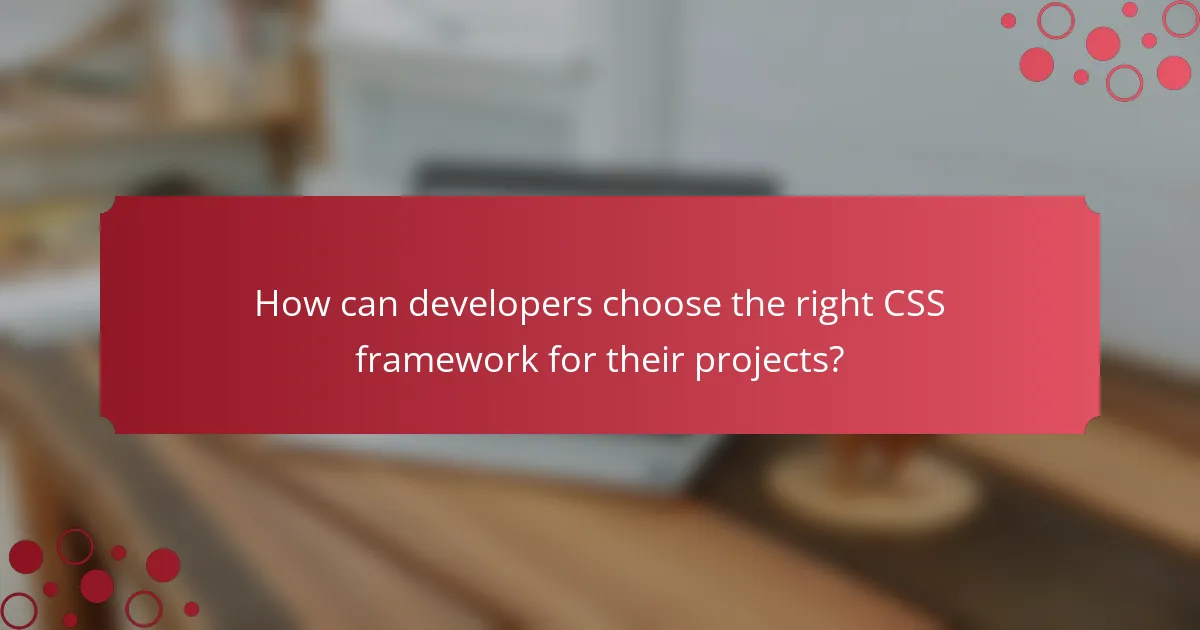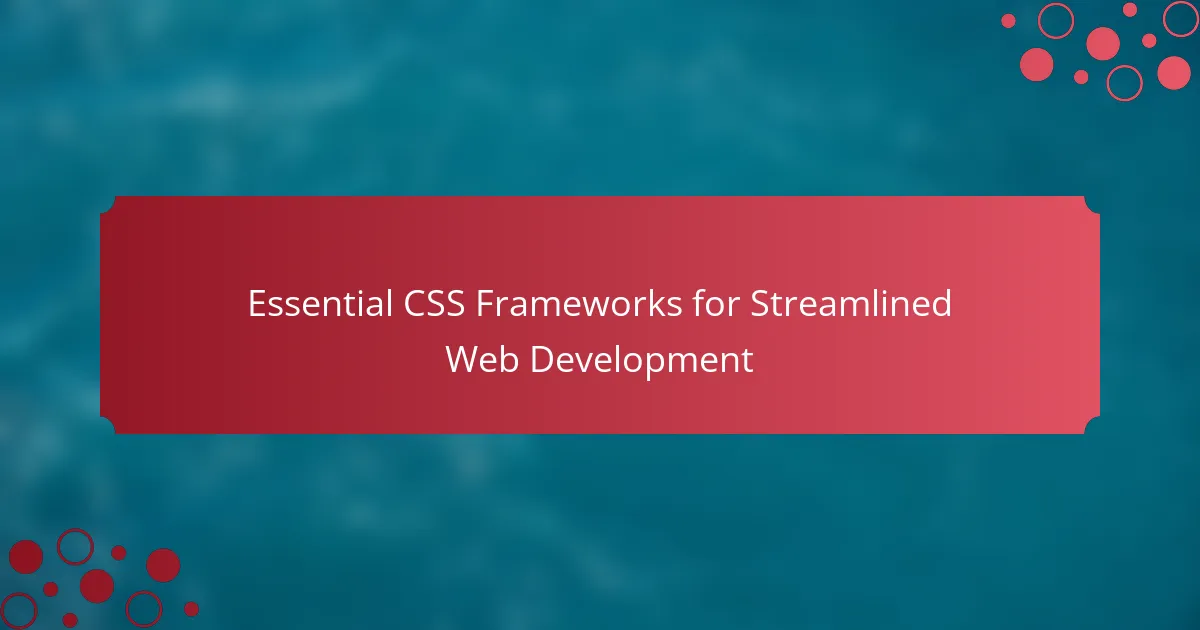Essential CSS frameworks play a critical role in streamlining web development, with popular options including Bootstrap, Foundation, Bulma, Tailwind CSS, and Materialize. Bootstrap is recognized for its responsive grid system and a wide range of pre-built components, while Tailwind CSS emphasizes utility-first styling for rapid customization. Foundation offers a mobile-first approach with advanced flexibility, and Bulma is based on Flexbox, providing a modern design. Materialize incorporates Google’s Material Design principles for a clean aesthetic. Developers can select the most suitable framework by evaluating project requirements, design flexibility, ease of use, community support, performance, and compatibility with existing technologies.

What are Essential CSS Frameworks for Streamlined Web Development?
Essential CSS frameworks for streamlined web development include Bootstrap, Foundation, Bulma, and Tailwind CSS. Bootstrap is widely used for its responsive grid system and extensive components. Foundation offers a flexible grid and advanced customization options. Bulma is known for its modern design and simplicity. Tailwind CSS provides utility-first styling, allowing for rapid design without leaving HTML. These frameworks enhance productivity and ensure consistent design across web projects.
How do CSS frameworks enhance web development efficiency?
CSS frameworks enhance web development efficiency by providing pre-designed styles and components. These frameworks reduce the time developers spend on coding from scratch. They offer a consistent design language across projects. Frameworks like Bootstrap and Foundation include grid systems for responsive layouts. This allows developers to create mobile-friendly sites faster. Additionally, they come with built-in JavaScript plugins for common functionalities. This reduces the need for additional coding. Studies show that using frameworks can decrease development time by up to 50%. This efficiency leads to quicker project turnaround and improved collaboration among teams.
What key features do CSS frameworks offer to developers?
CSS frameworks offer developers a collection of pre-designed components and styles. These frameworks streamline the web development process. They provide grid systems for responsive layouts. This allows developers to create adaptable designs for various screen sizes. CSS frameworks also include reusable UI components. Examples are buttons, forms, and navigation bars. They often come with built-in browser compatibility. This reduces the need for extensive cross-browser testing. Additionally, CSS frameworks promote consistency in design. This helps maintain a cohesive look across web applications.
How do CSS frameworks simplify the design process?
CSS frameworks simplify the design process by providing pre-designed components and styles. These frameworks reduce the need for writing custom CSS from scratch. They offer a consistent design language across different projects. Frameworks like Bootstrap and Foundation include grid systems for responsive layouts. This allows developers to create adaptable designs easily. They also include UI elements such as buttons, forms, and navigation bars. Using these elements saves time and effort in design implementation. Additionally, CSS frameworks often come with built-in browser compatibility. This ensures that designs look good on various devices and browsers without extra work.
Why should developers consider using CSS frameworks?
Developers should consider using CSS frameworks for efficient and consistent styling. CSS frameworks provide pre-designed components and styles that speed up the development process. They help maintain uniformity across different browsers and devices. Frameworks like Bootstrap and Foundation are widely used for their responsive design features. These frameworks reduce the need for writing repetitive CSS code. They also offer built-in grid systems that simplify layout creation. Using a framework can enhance collaboration among team members by providing a common structure. According to a survey by Stack Overflow, 31.9% of developers use CSS frameworks regularly, indicating their popularity and utility.
What are the advantages of using a CSS framework over custom CSS?
Using a CSS framework offers several advantages over custom CSS. First, CSS frameworks provide pre-built components that accelerate development. This reduces the time required to design and implement styles. Second, frameworks ensure consistent styling across different browsers and devices. They include reset styles and responsive design features that enhance compatibility. Third, they promote best practices and maintainability. Frameworks often follow a modular approach, making it easier to manage and update styles. Finally, using a framework can improve collaboration among developers. Shared standards lead to a more cohesive codebase.
How can CSS frameworks improve website responsiveness?
CSS frameworks improve website responsiveness by providing pre-defined grid systems and responsive design components. These frameworks utilize flexible layouts that adapt to various screen sizes. They often include media queries that allow for different styles based on device characteristics. Frameworks like Bootstrap and Foundation offer built-in classes for responsive images and typography. This reduces the amount of custom CSS developers need to write. By using these frameworks, developers can ensure consistency across devices. Studies show that responsive designs can lead to better user engagement and lower bounce rates. According to a Google report, responsive websites can increase mobile traffic by up to 70%.

What are the most popular CSS frameworks available?
The most popular CSS frameworks available include Bootstrap, Tailwind CSS, Foundation, Bulma, and Materialize. Bootstrap is widely recognized for its responsive grid system and extensive pre-built components. Tailwind CSS focuses on utility-first design, allowing for rapid customization. Foundation is known for its mobile-first approach and flexibility. Bulma offers a modern CSS framework based on Flexbox. Materialize implements Google’s Material Design principles for a clean aesthetic. These frameworks are widely used by developers to streamline web development processes.
Which CSS frameworks are widely used in the industry?
Bootstrap, Foundation, and Bulma are widely used CSS frameworks in the industry. Bootstrap is known for its responsive design and extensive component library. Foundation is recognized for its flexibility and mobile-first approach. Bulma offers a modern and clean syntax, making it easy to use. According to a survey by Stack Overflow in 2021, Bootstrap remains the most popular CSS framework among developers. These frameworks provide pre-built styles and components, speeding up the web development process. They are widely adopted due to their robust documentation and community support.
What are the unique attributes of Bootstrap?
Bootstrap’s unique attributes include a responsive grid system, pre-built components, and extensive customization options. The responsive grid system allows developers to create layouts that adapt to different screen sizes. Pre-built components, such as navigation bars and modals, accelerate the development process. Bootstrap also offers extensive customization through its Sass variables and mixins. Additionally, it provides built-in JavaScript plugins for enhanced functionality. These attributes make Bootstrap a versatile choice for web development. Its widespread use is evidenced by its large community and extensive documentation.
How does Foundation differ from other frameworks?
Foundation differs from other frameworks through its mobile-first approach and advanced grid system. It prioritizes responsive design, ensuring optimal performance on various devices. Foundation offers customization options that allow developers to tailor components to specific project needs. Its built-in accessibility features enhance usability for all users. Additionally, Foundation includes a robust set of tools for creating complex layouts. Compared to Bootstrap, Foundation provides more flexibility in design choices. This versatility makes it suitable for both small projects and large-scale applications. Overall, Foundation stands out for its focus on customization and responsive design.
What are the key characteristics of Tailwind CSS?
Tailwind CSS is a utility-first CSS framework designed for rapid UI development. It provides low-level utility classes that enable developers to build custom designs without leaving their HTML. Tailwind promotes a consistent design system through its configurable design tokens. It supports responsive design with mobile-first breakpoints integrated directly into class names. The framework also encourages the use of components through its JIT (Just-In-Time) mode, which generates styles on-demand. Tailwind’s extensive documentation offers clear guidelines and examples for effective usage. Additionally, it features a plugin system that allows for further customization and extension. These characteristics make Tailwind CSS a powerful tool for modern web development.
How does Tailwind CSS promote utility-first design?
Tailwind CSS promotes utility-first design by providing a comprehensive set of low-level utility classes. These classes allow developers to build custom designs directly in their markup. Instead of writing custom CSS for each component, developers can apply utility classes to achieve the desired styling. This approach enhances efficiency by reducing the need for context switching between HTML and CSS files. Tailwind’s design philosophy encourages reusability of classes, which leads to more consistent design across projects. Additionally, the framework includes features like responsive design utilities and hover states built into its class structure. This further simplifies the development process, making it faster and more intuitive.
What are the benefits of using Bulma for rapid development?
Bulma offers several benefits for rapid development. It provides a modern, responsive design out of the box. Bulma uses a flexbox-based grid system, enabling easy layout management. Its syntax is simple and intuitive, which accelerates the development process. The framework includes a variety of pre-designed components, reducing the need for custom styling. Bulma is lightweight, ensuring fast loading times for web applications. Additionally, it is modular, allowing developers to include only the components they need. This flexibility supports quicker iterations and prototyping. Overall, these features make Bulma a strong choice for efficient web development.

How can developers choose the right CSS framework for their projects?
Developers can choose the right CSS framework by evaluating project requirements and team expertise. They should consider factors such as design flexibility, ease of use, and community support. Popular frameworks like Bootstrap and Tailwind CSS offer different advantages. Bootstrap provides a comprehensive set of pre-designed components. Tailwind CSS allows for more customization with utility-first classes. Developers should also assess the framework’s performance and loading speed. Compatibility with existing technologies is crucial for seamless integration. Finally, reviewing documentation and available resources can aid in the decision-making process.
What factors should influence the selection of a CSS framework?
The selection of a CSS framework should be influenced by factors such as project requirements, ease of use, community support, and performance. Project requirements dictate the specific features and functionalities needed. Ease of use affects the learning curve and development speed. Community support ensures access to resources and troubleshooting assistance. Performance impacts page load speed and overall user experience. Framework popularity can indicate reliability and ongoing updates. Compatibility with existing technologies is crucial for seamless integration. Finally, customization options allow developers to tailor the framework to their needs.
How does project scope impact framework choice?
Project scope significantly impacts framework choice by dictating the required features and complexity of the project. A broader project scope often necessitates a more robust framework that can handle diverse functionalities. For example, large-scale applications may require frameworks like Bootstrap or Foundation, which offer extensive components and customization options. Conversely, a narrow project scope may allow for simpler frameworks, such as Bulma or Tailwind CSS, which focus on minimalism and ease of use. The specific needs, such as responsiveness and design consistency, also influence the choice of framework. Ultimately, aligning the framework with the project scope ensures efficient development and optimal performance.
What role does team familiarity with a framework play in selection?
Team familiarity with a framework significantly influences selection. Familiarity reduces the learning curve associated with adopting new tools. It allows teams to leverage existing knowledge for quicker implementation. Familiar teams can also identify potential issues early in the process. This leads to more efficient collaboration and communication. Familiarity enhances confidence in using the framework effectively. Studies show that teams familiar with a framework report higher productivity levels. Thus, team familiarity is a critical factor in selecting a framework for web development.
What are best practices for implementing a CSS framework?
Use a CSS framework by following best practices for optimal results. First, choose a framework that aligns with your project needs. Popular options include Bootstrap and Tailwind CSS. Next, customize the framework to avoid unnecessary bloat. Remove unused styles and components to enhance performance. Organize your CSS files logically to improve maintainability. Implement responsive design principles to ensure compatibility across devices. Test your design in multiple browsers for consistency. Lastly, keep the framework updated to leverage improvements and security patches. These practices ensure efficient use of CSS frameworks in web development.
How can developers effectively customize a CSS framework?
Developers can effectively customize a CSS framework by using variables, mixins, and overriding styles. Many frameworks, like Bootstrap or Tailwind, provide a set of predefined variables. These variables allow developers to change colors, fonts, and spacing easily. Developers can create custom mixins for reusable styles, enhancing consistency across the project. Overriding existing styles is also crucial. This can be done by writing specific CSS rules that take precedence over the framework’s default styles. The use of specificity in CSS ensures that custom styles are applied correctly. Additionally, utilizing a preprocessor like SASS can streamline this process. SASS allows for nested rules and functions, making customization more efficient. By following these methods, developers can tailor a CSS framework to fit their project’s unique design requirements.
What common pitfalls should be avoided when using CSS frameworks?
Common pitfalls to avoid when using CSS frameworks include over-reliance on default styles. This can lead to a lack of unique branding. Additionally, ignoring customization options can result in a generic look. Not understanding the framework’s grid system may cause layout issues. Failing to optimize for performance can slow down website loading times. Overusing utility classes can lead to messy HTML. Lastly, neglecting to keep the framework updated can introduce security vulnerabilities. These pitfalls can hinder the effectiveness of web development projects.
What resources are available for learning about CSS frameworks?
Online platforms such as W3Schools and Codecademy offer comprehensive tutorials on CSS frameworks. These resources provide structured lessons and interactive coding exercises. Books like “CSS Secrets” by Lea Verou also delve into advanced techniques. Additionally, documentation from popular frameworks like Bootstrap and Tailwind CSS is invaluable. These official resources include guides, examples, and community support. Video courses on platforms like Udemy and Coursera cover CSS frameworks extensively. Forums such as Stack Overflow enable discussion and troubleshooting among learners. These resources collectively enhance understanding and practical skills in CSS frameworks.
Essential CSS frameworks for streamlined web development include Bootstrap, Foundation, Bulma, and Tailwind CSS, each offering unique features that enhance productivity and ensure consistent design. The article explores how these frameworks improve web development efficiency by providing pre-designed styles, responsive grid systems, and built-in JavaScript plugins. Key characteristics, advantages, and best practices for implementing these frameworks are discussed, alongside factors influencing the selection of a suitable framework based on project requirements and team familiarity. Additionally, common pitfalls and resources for learning about CSS frameworks are highlighted to support developers in optimizing their web development processes.
